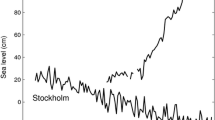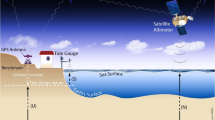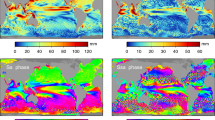Abstract
A tide gauge situated on the western shore of Minamitorishima, a small atoll in the western Pacific, has measured sea levels significantly impacted by wave setup. Evidence for this rests with (a) strong correlations between sea level anomalies and high swell and (b) sea-level differences with satellite altimetry that display near-linear dependence on offshore swell heights (regression coefficient 30 cm per meter of swell). Setup is primarily induced by swell from the northwest. We develop models of wave setup which lead to corrected sea levels better reflecting the surrounding ocean, and thus more readily useful to studies of regional sea level and practical applications such as altimetry calibration. The wave setup is also evidently affecting measurements of the tide, with suppressed tide amplitudes in winter when swell is generally largest. In February 2020 the tide gauge was relocated to the southern shore of the island, and the wave setup is now markedly reduced.













Similar content being viewed by others
Data Availability
DUACS altimeter data are available from the Copernicus Marine Service https://marine.copernicus.eu. The ECMWF ERA5 wave data are available from the Copernicus Climate Change Service https://cds.climate.copernicus.eu. Tide gauge data are available from the University of Hawaii Sea Level Center https://uhslc.soest.hawaii.edu.
Notes
We have confirmed that the phase of wave setup obtained here using our empirical model is consistent with the presumed annual cycle of infragravity wave energy at the atoll. The latter was estimated by computing the rms of 1-minute sea levels within 4-hour windows using three years of data from the MISELA dataset (Zemunik et al. 2021), detided and high-pass filtered with a 2-hour cutoff.
References
Aucan J, Hoeke R, Merrifield MA (2012) Wave-driven sea level anomalies a the Midway tide gauge as an index of North Pacific storminess over the past 60 years. Geophys Res Lett 39:17. https://doi.org/10.1029/2012GL052993
Becker JM, Merrifield MA, Ford M (2014) Water level effects on breaking wave setup for Pacific Island fringing reefs. J Geophys Res Oceans 119:914–935. https://doi.org/10.1002/2013JC009373
Bidlot JR (2016) Ocean wave model output parameters, ECMWF Report. https://confluence.ecmwf.int/download/attachments/59774192/wave_parameters.pdf. Accessed 22 Feb 2022
Blewitt G, Hammond WC, Kreemer C (2018) Harnessing the GPS data explosion for interdisciplinary science. EOS 99. https://doi.org/10.1029/2018EO104623
Carrère L, Faugère Y, Ablain M (2016) Major improvement of altimetry sea level estimations using pressure-derived corrections based on ERA-Interim atmospheric reanalysis. Ocean Sci 12:825–842. https://doi.org/10.5194/os-12-825-2016
Cazenave A, Dominh K, Ponchaut F, Soudarin L, Cretaux JF, Le Provost C (1999) Sea level changes from Topex-Poseidon altimetry and tide gauges, and vertical crustal motions from DORIS. Geophys Res Lett 26:2077–2080
Cheney R, Miller L, Agreen R, Doyle N, Lillibridge J (1994) TOPEX/POSEIDON: the 2-cm solution. J Geophys Res Oceans 99:24555–24563
Cheriton OM, Storlazzi CD, Rosenberger KJ (2016) Observations of wave transformation over a fringing coral reef and the importance of low-frequency waves and offshore water levels to runup, overwash, and coastal flooding. J Geophys Res Oceans 121:3121–3140. https://doi.org/10.1002/2015JC011231
Dodet G, Melet A, Ardhuin F, Bertin X, Idier D, Almar R (2019) The contribution of wind-generated waves to coastal sea-level changes. Surv Geophys 40:1563–1601. https://doi.org/10.1007/s10712-019-09557-5
Gourlay MR (1996) Wave set-up on coral reefs. 2. Set-up on reefs with various profiles. Coast Eng 28:17–55
Hersbach H et al (2020) The ERA5 global reanalysis. Q J R Met Soc 146:1999–2049. https://doi.org/10.1002/qj.3803
Hoeke RK, McInnes KL, Kruger JC, McNaught RJ, Junter JR, Smithers SG (2013) Widespread inundation of Pacific islands triggered by distant-source wind-waves. Glob Planet Change 108:128–138. https://doi.org/10.1016/j.gloplacha.2013.06.006
Holman RA, Sallenger AH (1985) Setup and swash on a natural beach. J Geophys Res 90:945–953
Longuet-Higgins MS, Stewart RW (1962) Radiation stress and mass transport in gravity waves, with application to surf-beats. J Fluid Mech 13:481–504
Lugo-Fernández A, Roberts HH, Wiseman WJ (1998) Tide effects on wave attenuation and wave set-up on a Caribbean coral reef. Estuar Coast Shelf Sci 47:385–393
Merrifield MA, Becker JM, Ford M, Yao Y (2014) Observations and estimates of wave-driven water level extremes at the Marshall Islands. Geophys Res Lett 41:7245–7253. https://doi.org/10.1002/2014GL061005
Mitchum GT (1998) Monitoring the stability of satellite altimeters with tide gauges. J Atmos Ocean Tech 15:721–730
Monismith SG (2007) Hydrodynamics of coral reefs. Ann Rev Fluid Mech 39:37–55. https://doi.org/10.1146/annurev.fluid.38.050304.092125
Monismith SG, Herdman LMM, Ahmerkamp S, Hench JL (2013) Wave transformation and wave-driven flow across a steep coral reef. J Phys Oceanogr 43:1356–1379. https://doi.org/10.1175/JPO-D-12-0164.1
Munk WH, Sargent MC (1948) Adjustment of Bikini Atoll to ocean waves. Trans Am Geophys Union 29:855–860 (reprinted in Geological Survey Prof. Paper 260-C, U. S. Govt. Printing Off., Washington, 1954)
Pomeroy A, Lowe R, Symonds G, Van Dongeren A, Moore C (2012) The dynamics of infrafravity wave transformation over a fringing reef. J Geophys Res Oceans 117:C11022. https://doi.org/10.1029/2012JC008310
Pujol MI, Faugère Y, Tauburet G, Dupuy S, Pelloquin C, Ablain M, Picot N (2016) DUACS DT2014: the new multi-mission altimeter data set reprocessed over 20 years. Ocean Sci 12:1067–1090. https://doi.org/10.5194/os-12-1067-2016
Raubenheimer B, Guza RT, Elgar S (1996) Wave transformation across the inner surf zone. J Geophys Res 101:25589–25597
Ray RD, Beckley BD, Lemoine FG (2010) Vertical crustal motion derived from satellite altimetry and tide gauges, and comparisons with DORIS. Adv Space Res 45:1510–1522. https://doi.org/10.1016/j.asr.2010.02.020
Ray RD, Loomis BD, Zlotnicki V (2021) The mean seasonal cycle in relative sea level from satellite altimetry and gravimetry. J Geod 95:80. https://doi.org/10.1007/s00190-021-01529-1
Taburet G, Sanchez-Roman A, Ballarotta M, Pujol MI, Legeais JF, Fournier F, Faugère Y, Dibarboure G (2019) DUACS DT2018: 25 years of reprocessed sea level altimetry products. Ocean Sci 15:1207–1224. https://doi.org/10.5194/os-15-1207-2019
Tran N, Labroue S, Philipps S, Bonner E, Picot N (2010) Overview and update of the sea state bias corrections for the Jason-2, Jason-1 and TOPEX missions. Mar Geod 33:348–362
Vetter O, Becker JM, Merrifield MA, Pequignet AC, Aucan J, Boc SJ, Pollock CE (2010) Wave setup over a Pacific Island fringing reef. J Geophys Res 115:C12066. https://doi.org/10.1029/2010JC006455
Vinogradov SV, Ponte RM (2010) Annual cycle in coastal sea level from tide gauges and altimetry. J Geophys Res 115:C04021. https://doi.org/10.1029/2009JC005767
Vinogradov SV, Ponte RM (2011) Low-frequency variability in coastal sea level from tide gauges and altimetry. J Geophys Res 116:C07006. https://doi.org/10.1029/2011JC007034
Walsh EJ, Jackson FC, Uliana E, Swift RN (1989) Observations on electromagnetic bias in radar altimeter sea surface measurements. J Geophys Res 94:14575–14584
Williams J, Hughes CW (2013) The coherence of small island sea level with the wider ocean: a model study. Ocean Sci 9:111–119. https://doi.org/10.5194/os-9-111-2013
Woodworth PL (2020) Wave setup at Tristan de Cunha. Afr J Mar Sci 42:233–245. https://doi.org/10.2989/1814232X.2020.1776390
Woodworth PL et al (2019) Factors affecting sea level changes at the coast. Surv Geophys 40:1351–1397. https://doi.org/10.1007/s10712-019-09531-1
Zemunik P, Šepić J, Pellikka H, Ćatipović L, Vilibić I (2021) Minute sea-level analysis (MISELA): a high-frequency sea-level analysis global dataset. Earth Syst Sci Data 13:4121–4132. https://doi.org/10.5194/essd-13-4121-2021
Acknowledgements
We thank Gary Mitchum and Janet Becker for useful discussions. The tide gauge at Minamitorishima is operated by the Japan Meteorological Agency, Minato City, Tokyo. The agency kindly provided us useful information about the tide gauge instrument and its relocation. The daily data were downloaded from the University of Hawaii Sea Level Center. ECMWF data were obtained from https://cds.climate.copernicus.eu. This work was partially supported by the U.S. National Aeronautics and Space Administration through the Sea Level Change and Sentinel-6 programs and by the U.S. Army Corps of Engineers (W912HZ192).
Author information
Authors and Affiliations
Corresponding author
Appendices
Appendix A: Consistency of altimeter and tide-gauge data processing
The source of the satellite altimeter sea-level data used in this work is the Data Unification and Altimeter Combination System (DUACS) delayed-time (DT-2018) product, described by Taburet et al. (2019). These are gridded sea-surface height anomalies, produced daily on a 0.25\(^{\circ }\) global grid and based on multiple satellite missions.
The tide gauge data are in the form of daily means, formed after hourly data were subjected to an anti-aliasing low-pass filter with cutoff about 60 hours. When these data were used in comparison with altimetry, as in Figs. 2 and 7, the daily mean values were subjected to additional low-pass filtering to account for the temporal smoothing used in the DUACS solutions. The DUACS gridding algorithm used temporal correlation scales ranging from 10 to 33 days, depending on latitude (Pujol et al. 2016); at the latitude of Minamitorishima the correlation scale was approximately 29 days, so our tide-gauge filter had approximately that cutoff. However, when used in the wave-setup analysis of Sects. 4–5, the daily means were not further filtered as the goal was to capture relatively high-frequency setup anomalies.
In all accounts, it is necessary to ensure that the tide gauge data be processed in a manner as consistent as possible with the processing of the altimetry. Thus, the tide gauge data were “corrected” for long-period tides (periods between one week and 18.6 y) and the pole tide (dominant periods at 12 and 14 months). In both cases, only the ocean components were removed from the gauge data, whereas the altimetry required both ocean and solid-earth components. The altimeter data had also been adjusted by the ocean model of Carrère et al. (2016), which is a simple isostatic inverted-barometer response to pressure loading at periods longer than 20 days and a dynamic response to both winds and pressures at shorter periods. Since the Nyquist period of Topex and Jason sampling is 20 days, the idea behind the dynamic modeling is to act as a de-aliasing correction. We subsequently used the same model to remove these effects from the tide gauge data. In principle, the tide gauge data should also be adjusted for vertical land motion, but we ignored this because the motion is thought to be small, less than 0.5 mm year\(^{-1}\) based on the island GNSS data (see Appendix B).
Appendix B: Vertical land motion at Minamitorishima
Global Navigation Satellite System (GNSS) data have been collected on the island since 1995. In the international GNSS archives there are two stations, MARC and MCIL, from nearly identical locations (24.2901\(^{\circ }\)N, 153.9787\(^{\circ }\)E). The older MARC time series is short and relatively noisy. Daily estimates of vertical position as extracted by Blewitt et al. (2018) from both stations are shown in Fig. 12.
Our final time series of altimeter and tide-gauge differences (Fig. 7, lower panel) is a proxy measure for vertical position of the tide gauge (e.g. Cazenave et al. 1999). The altimeter-gauge differences are somewhat erratic during the first few years of the record, which (aside from many other errors) could be explainable by anomalous ground motion. However, the GNSS series at MARC is too noisy to shed light on the question.
The vertical rate as implied by the MCIL data is \(-0.39 \pm 0.52\) mm year\(^{-1}\). The corresponding rate from the altimeter-gauge differences of Fig. 7 is \(0.95 \pm 1.0\) mm year\(^{-1}\). The uncertainty takes account of serial correlation in the time series. Within the given uncertainties the GNSS and altimeter-gauge rates are consistent even though of different sign; both overlap with zero motion. Together, they suggest the island motion has been small over the period since 1997.
Appendix C: Altimeter estimates of seasonal M\(_2\) changes
It is desirable to know how the tide as observed at Minamitorishima (Fig. 10) compares with the tide in the surrounding deep water. Altimetry can determine this, but some care is required owing to the lack of nearby satellite tracks and the inherent aliasing problems of altimetry.
Figure 13 shows four sets of repeat tracks on the primary Topex/Poseidon-Jason orbit. Estimation of subseasonal M\(_2\) coefficients at the one track closest to the island yields rather noisy estimates, so we have used data from all four tracks. Combining data within the magenta rectangular region of the figure, we have estimated the mean tide and its spatial gradients, and used the latter to determine the tide at the island location. (This approach works so long as there is little curvature over the region; according to the tide chart plotted in the figure background, that is here the case.) Mean monthly M\(_2\) estimates (as could be done at the tide gauge—Fig. 10) were again rather noisy, so we solved for mean quarterly (i.e., 3-month) tides. Resulting M\(_2\) amplitudes are shown in Fig. 13b. There is no seasonal change comparable to the \(\sim \!20\)% seasonal range seen at the tide gauge, and certainly no large amplitude drop during winter months when the tide gauge gave amplitudes less than 7.5 cm. Only the tide-gauge estimates for the summer months are comparable to the altimetric tide.
Rights and permissions
About this article
Cite this article
Ray, R.D., Merrifield, M.A. & Woodworth, P.L. Wave setup at the Minamitorishima tide gauge. J Oceanogr 79, 13–26 (2023). https://doi.org/10.1007/s10872-022-00659-0
Received:
Revised:
Accepted:
Published:
Issue Date:
DOI: https://doi.org/10.1007/s10872-022-00659-0




